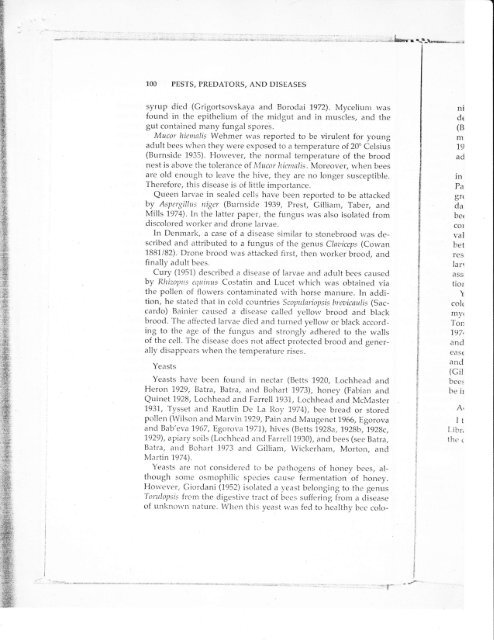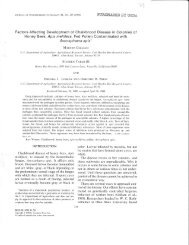Chalkbrood - Status Today and Hopes for Control' - Golden Rule Honey
Chalkbrood - Status Today and Hopes for Control' - Golden Rule Honey
Chalkbrood - Status Today and Hopes for Control' - Golden Rule Honey
You also want an ePaper? Increase the reach of your titles
YUMPU automatically turns print PDFs into web optimized ePapers that Google loves.
lOO PESTS, PREDATORS, AND DISEASES<br />
syrup died (Grigortsovskaya <strong>and</strong> Boroclai 7972). Myceliunr was<br />
found in the epithelium of the miclgut <strong>and</strong> in muscles, <strong>and</strong> the<br />
gut contained many fungal spores.<br />
Mucor hiennlis Wehmer rvas reported to be virulent <strong>for</strong> young<br />
adrrlt bees rvhen tl'rey \vere exposed to a temperature of 20' Celsius<br />
(Burnside 1935). Hon'ever, the normal temperature of the brood<br />
nest is abor.'e the tolerance of lvhrcor liennlis. Moreove'r, when bees<br />
are old enough to leave the hive, they are no longer susceptible.<br />
There<strong>for</strong>e, this disease is of little importance.<br />
Queen larl,ae in sealed cells have beerr reported to be attacked<br />
by AsTtergillus niger (Burnside 1939, Prest, Gilliam, Taber, <strong>and</strong><br />
Mills 1974). In the latter paper, the fungus r,r'as also isolated from<br />
discolored rvorker <strong>and</strong> drone larvae.<br />
In f)enrnark, a case of a disease similar to stonebrood rvas described<br />
<strong>and</strong> attributed to a fungus of the €ienus Clauiceps (Cor,r,an<br />
188i/82). Drone t.'rood n'as attacked first, then rvorker brood, <strong>and</strong><br />
finalll'adult bees.<br />
Cury (1951) described a disease of iarvae arrd adult bees caused<br />
by Rhizopus equinus Costatin ar-rd Lucet rvhich was obtained via<br />
the pollen of florvers contaminated rvith horse manure. In addition,<br />
he stated that in cold countries Sco|rttlcrioltsis brqticnulis (Saccardo)<br />
Bainier caused a disease called yellorv brood <strong>and</strong> black<br />
brood. The affectcd larvae died <strong>and</strong> turned yellow or black accorclirrg<br />
to the age of the fungus <strong>and</strong> strongly adhered to the walls<br />
of the ce.il. The disease does not affect protected broocl <strong>and</strong> generalll'<br />
disappears rvhen the temperature riscs.<br />
Yeasts<br />
Yeasts have been fourrd in nectar (tsetts 1920, Lochhead <strong>and</strong><br />
Heron 1.929, Batra, Batra, <strong>and</strong> Bohart 7973), honey (Falrian <strong>and</strong><br />
Quinet 1928, l.ochhead <strong>and</strong> Farrell 1931, l.ochheacl <strong>and</strong> lvlclr{aster<br />
1931, Tvsset <strong>and</strong> Rautiin De l-a Ror, 1974), bee bread or stored<br />
pollerr (lVilson <strong>and</strong> Man'irr 1929, Pain ancl Maugerrct7966, Egorova<br />
arrd Bab'eva 7967, Egnrova 1971), hives (Betts 7928a,1928b,1928c,<br />
1929), apiarv soils (Lochhe.rd ancl Farrell1930), <strong>and</strong> bees (see Batra,<br />
Batra, <strong>and</strong> Bohart 1973 arrcl Gilliam, \{ickerham, Morton, <strong>and</strong><br />
N4artin 1974).<br />
Yeasts are not considercd to be pathogL'l1s of honey trees, although<br />
soltlc osmophilic species ciiuse fermentation of honey.<br />
How'ever, Giordani (1952) isol.-rted a veast belonging to thc genus<br />
Torulopsis from the digestir,e tract of bce.s suffe'ri.g from a tiisease<br />
of unkrrorvrr nature. \{hen this yeast n'.rs fe'd to healthl.bee colo-<br />
..*i*-. L\F@.!<br />
t-<br />
ni<br />
dr<br />
(B<br />
m<br />
19<br />
ad<br />
ln<br />
Pa<br />
8r(<br />
cla<br />
ber<br />
COI<br />
val<br />
bet<br />
res<br />
larr<br />
ASS<br />
tior<br />
\<br />
col<<br />
m)/l<br />
Ton<br />
197,<br />
<strong>and</strong><br />
Cc'l S(<br />
<strong>and</strong><br />
(Gil<br />
bee:<br />
be ir<br />
A,<br />
It<br />
L-ibr,<br />
ihc r



